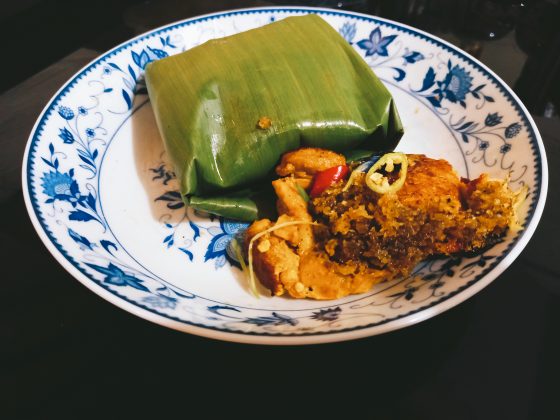A RECENT dinner tried to explain what the Manila district of Quiapo means to the Philippine consciousness, by serving up delicacies that can only be found on its streets.
On Nov. 13, students from the Introduction of Cultural Heritage class of the Ateneo de Manila University, taught by Dr. Fernando Zialcita, threw an online dinner called “Quiapo À La Carte: Food Culture in Transit,” with dishes chosen by book designer, food writer, and culinary historian Ige Ramos, as prepared by chef Waya Araos-Wijangco (of Gourmet Gypsy).
“We celebrate this event every year in relation to the field school where we had our research,” Mr. Zialcita said during the dinner, which was held via Zoom. Other locations which were celebrated in this manner in previous semesters include Bohol, Tayabas, Silay, Vigan, and Carcar. “Now, it’s high time to celebrate the food of a district in Manila, and that’s Quiapo,’ he said.
“Ang pagkatao ng isang komunidad at kanyang lutuin ay magkasanib. Nagiging mahalagang expresyon hindi lang ng panlasa ng komunidad ang lutuin, kundi pati na rin ang kanyang kasaysayan at kabuhayan (The personality of a community and its cuisine work together. Cuisine becomes not only an expression of a community’s taste, but of its history and livelihood),” he said.
“Pinagaralan namin kung paano naiba ang Quiapo sa kanyang mga landmarks, sa kanyang pang-araw-araw na pamumuhay at sa kanyang lutuin (We studied what made Quiapo unique by its landmarks, its daily life, and its cuisine).”
QUIAPO AS MELTING POT
As it is, Quiapo takes its name from a floating water lily species, locally known as Kiyapo — much like how Manila took its name from another plant; tying their destinies together (and giving homage to the Pasig River which gave them life).
The area was one of the country’s earliest settled sites, and throughout the various periods of the nation’s history, its changes have reflected the country’s own. It had been a site for the homes of some of the country’s elite, as well as the site of continued pilgrimage for the Black Nazarene in Quiapo Church. It has been a center of commerce, from the various businesses that have set up shop there, owned and managed by Filipinos of various extractions. At the same time, as one of the busiest districts in the capital, it has served as audience and stage for major political events, such as the Plaza Miranda bombing.
Mr. Ramos, explained how he thought up the dinner, which started out as an idea for a reflection paper for the audited classes he attended last June at the Ateneo Social and Cultural Laboratory. “We studied the link that connects the conservation of local heritage with responses to climate change. Quiapo was the chosen site this year,” he said.
“I’ve always been interested in Quiapo as a cultural food space, where food moves together with the natural landscape, changing urban planning, and, most especially, people’s transitory qualities,” he said. “Constantly moving, evolving; like an organism, it is born, nurtured, lives, and dies — completing the cycle of life.”
Different cultures have left their imprint upon Quiapo, reflected in the food and faith available there. In the same district, three cultures are present: the Spanish influences are seen through Quiapo church and San Sebastian Church; the Muslims are represented through the Golden Mosque, while the shops and eateries in the area are mostly Chinese-owned. The fortune-tellers and albularyos (herbalists) selling potions in the perimeter of Quiapo Church, meanwhile, point to deeply rooted Filipino folk beliefs, with some infusions of pre-colonial religion with a form of folk Catholicism.
“Beneath the mestizo-influenced cuisine, there are various food influences that one can glean in Quiapo. There are street food vendors, albularyos selling herbs and potions, fast foods, halal eateries, bakeries, and, at one point, a distillery, and, to this day, a big market situated by the river for easy access to produce and fresh ingredients benefitting both buyers and sellers,” said Mr. Ramos.
“There’s also the sinification of Philippine cuisine, or rather, the Filipinization of Chinese cuisine,” he said, pointing to vendors of taho (soybean custard in caramel sauce) and the various bakeries and eateries selling hopia (a local version of moon cake which is filled with mung beans), lumpia (spring rolls), mami (noodle soup), and siopao (Chinese savory filled buns).
The Golden Mosque built in 1972, of course, had to make room for the halal cuisine that would fill the stomachs of the Muslims who would worship there (which Mr. Ramos points out, is closer to the cuisines of our Southeast Asian neighbors).
“Quiapo is indeed a melting pot and these foodscapes are now part of the Philippine culinary canon, and are now embedded in our gastronomic DNA.”
Mr. Ramos quoted from Mexican poet and Nobel Prize winner Octavio Paz: “The melting pot is the social ideal that when applied to culinary art, produces abomination.” Mr. Ramos said, “I assure you that there’s nothing abominable with what you will partake tonight, especially when it comes from the kitchen of chef Waya.”
QUIAPO DINER
The dinner consisted of two bento boxes: one for merienda cena (a heavy afternoon meal), and the other for dinner, which had halal dishes.
The first course was Lumpiang Sariwa (fresh spring rolls) prepared in the manner of the one at the Globe Theater. The eatery has been around since the 1950s, serving its version of the dish made of heart of palm, crushed peanuts, and a homemade sauce — and, best of all, the whole thing costs P25.
Next up was the Rainbow Clubhouse sandwich with Excelente Ham, both pointing to efforts of Chinese entrepreneurs. The rainbow bread was made by Bakerite, which was established in 1946 when Wong Tong Liong, a baker of Chinese extraction, made a deal with a soldier for a truckload of flour. The rainbow bread has been a fixture at many Filipino children’s parties since. It was filled with Excelente Deboned Chinese Cooked Ham, whose popularity still rests within its lone site in Carlos Palanca St. in Quiapo (once known as Echague).
The second bento box showed a creamy and spicy beef rendang (stewed in coconut milk and spices), but also a veritable piece de resistance any chef would be proud of: Chicken Piaparan with Palapa, served with pastil. The pastil (cooked rice with a shredded meat topping wrapped in banana leaves) was tinted a delicate blue (presumably with the use of ternate flowers), and was served with Chicken Piaparan, a Maranao delicacy which saw chicken simmered in coconut milk and turmeric. This was served with palapa, a condiment of toasted grated coconut flavored with spices, but especially a scallion indigenous to Mindanao, turmeric, ginger, and chili (an uncle once joked that this was the reason why the Spanish came to the Philippines in the first place).
BUHAY QUIAPO
While guests on the Zoom call munched on these, Dr. Roz Li of Bakas Pilipinas (a New York-based heritage NGO) introduced Buhay Quiapo, a joint project of Bakas Pilipinas and the Department of Sociology and Anthropology of the Ateneo de Manila University.
“Quiapo is very big in the consciousness not just of people in Manila, but of the whole country,” she said. She pointed to Quiapo’s significance in the aesthetic, historical, religious, and economic sense, which is why it needs saving. As Mr. Ramos said, “We learned how to introduce new things, but we discarded the old and squandered our cultural capital,” pointing to Quiapo’s decline in the last 40 years or so.
Ms. Li said, “Now is a critical time for Quiapo. Although deteriorated, you can still feel its rich history and sense of place. Quiapo is presently under threat of obliteration, neglect, and new development.”
The objectives of the project include assessing the current state of Quiapo’s cultural heritage with a view towards conservation and revitalization, as well as identifying stakeholders, and formulating strategies with a view towards sustainable development and “overcoming poverty and inequality through creative and cultural human intervention approach.” Ms. Li summarizes it as: “How can Quiapo’s heritage improve the lives of the people in the community?”
Dinner concluded with closing remarks from Joel Oana, Senior Urban Planning and Development Consultant with the Manila City Planning Office. “Food is a key element in creating places. It fosters friendship and partnerships,” he said. “People, place, and partnership are what I consider in my planning practice as the key factors in the success of urban regeneration, and can only be sustained by caring and committed communities.”
Buhay Quiapo, with the partnership of the Ateneo Department of Sociology and Anthropology, will hold a series of talks beginning Nov. 19 called the “Living Heritage: Heritage Forum Series.” Find more details about the talks on facebook.com/ateneosocioanthro. — Joseph L. Garcia

















